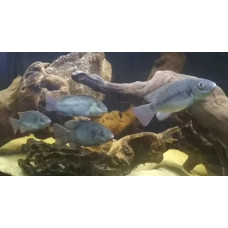Latin name
Sarotherodon galilaeus
Other names
Galilaea tilapia, Galilean comb, Galilee St. Peter's fish, and St. Peter's fish.
Identification
The mouth is small, with the lower jaw length being less than 1/3 of the total head length. The massive pharyngeal bone (about 40% of the total head length – comparable sizes are observed only in a few other tilapia species) is equipped with narrow, unicuspid teeth.
Features of fish fins
This species has large dorsal, anal, pectoral, and pelvic fins. The caudal fin is very weakly notched (almost truncate).
Fish colouring
The base body color of the Mango tilapia is typically pale yellow or grayish-green. Some specimens exhibit characteristic irregularly shaped, dark vertical bars of varying intensity on the upper body (up to 2/3 of the body height). Sexual dimorphism in body coloration is absent, including during the breeding season.
Distribution
It is found primarily in Africa, from its northern coast to 15° South latitude. In the Nile system, it is recorded in the delta lakes and Lakes Albert and Turkana; in the Congo Basin – in the middle reaches and lower parts of the Congo River itself from Matadi to the Malebo Pool, as well as in the lower Kasai River. In West Africa, it occurs in the Senegal, Gambia, Casamance, Geba, Konkouré, Sassandra, Bandama, Komoé, Niger, Volta, Tanoé, Mono, Ouémé, Ogun, Cross, Benue, Logon, Chari, Sanaga, and Nyong rivers, and in Lakes Bosumtwi and Chad. In northwestern Africa, it inhabits the Adrar region of Mauritania and the Draa River (Morocco), and the Saharan oases of Borkou, Ennedi, and Tibesti in northern Chad. Outside Africa, it is found in the Middle East – in the Jordan River system and coastal rivers of Israel. In the man-made Lakes Volta (on the Volta River), Kainji (on the Niger River), and Nasser (on the Nile), S. galilaeus has become the most prevalent tilapia species.
Habitat
Overall, this species predominates in water bodies with sandy bottoms and shores, whereas another common tilapia species, S. niloticus, is more often found in water bodies with muddy bottoms. It leads a bottom-dwelling lifestyle at depths from 5 meters, mainly in open water, although juveniles and breeding individuals can also be found near the shore. It prefers temperatures from 22°C to 28°C, but there have been reports of individuals surviving in water as cold as 9°C.
Size
The Mango tilapia is a medium-sized fish (for a Cichlid). The average body length at sexual maturity is 19.1 cm, with a minimum of about 16 cm. The maximum recorded length is 41 cm with a weight of 1.6 kg. The average body depth is 45% of the length (can vary from 43% to 56%). The head length ranges from 32.5% to 39% of the total body length.
Behavior
It inhabits fresh and brackish waters, migrating only between such water bodies. It is a territorial species but may sometimes form schools.
Food and feeding habits
Its diet consists primarily of algae and fine organic detritus.
Reproduction
During the breeding season, temporary pairs form. After spawning, both males and females practice mouthbrooding. The fry also find refuge in the parent's mouth initially. While foraging, they swim around the mother, but as soon as danger appears, the mother signals by lowering her head and raising her tail, starting to move backward. This means "take shelter," and the fry immediately rush to the proven refuge – her mouth.
Fishing
It is a popular commercial fish, especially important in Israel, Jordan, Egypt, Ghana, and Benin. It is caught with nets in Lake Kinneret, the Nile Delta lakes, and the Kainji and Volta reservoirs; in Nigeria, fish traps are used for this purpose. Modern anglers and researchers successfully catch Galilean tilapia using spinning gear, such as small spoons and crankbaits. Spinning competitions for this fish are held annually in Israel.
Relationship with people
Galilean tilapia is offered to tourists in restaurants as the fish that, according to the Gospel of Matthew, the Apostle Peter caught on a hook with a stater in its mouth (Matthew 17:27). However, the Gospel does not specify which fish Peter caught, or if he even caught one—it only relays the instruction to catch a fish. The identification of tilapia as the "St. Peter's fish" caught on a hook is debated among some anglers, who suggest that a barbel from the genus Barbus or Capoeta is a more likely candidate. However, Simon Peter was a fisherman before his apostleship, and it is reasonable to assume that tilapia made up a significant part of his catches; thus, "St. Peter's fish" could refer to the fish he caught with nets.
| Classification | |
| Phylum | Chordata |
| Class | Actinopterygii |
| Squad | Cichliformes |
| Family | Cichlidae |
| Genus | Sarotherodon |
| Species | S. galilaeus |
| Features | |
| Conservation status | Least Concern |
| Habitat | Pelagic |
| Life span, years | No information |
| Maximum body weight, kg | 1,6 |
| Maximum length, cm | 41 |
| Sailing speed, m/s | No information |
| Threat to people | Edible |
| Way of eating | Planktonophage |
Mango tilapia
Tags: mango tilapia

